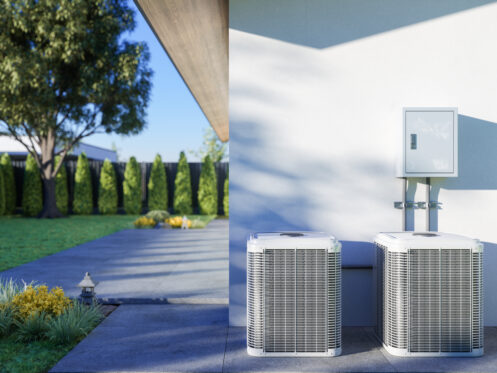Installing a modern HVAC system in your historic property requires some specific considerations. Many of these structures don’t have the space or ductwork required to handle new air conditioners or furnaces. The property’s electrical system may also need improvements to be able to support current indoor comfort systems. Working with a professional who is experienced in adding systems to older properties can help you to avoid a lot of problems when installing them. Read on to learn about modern HVAC options for historic properties.
Challenges with Historic Buildings
The first step in evaluating your historic building is to determine your long-term preservation goals. Do you want to keep your building as close to original condition as possible or to modernize but keep a few architectural features to honor the original style? Work with an HVAC professional about your goals and sideboards.
Older buildings come with specific challenges. Delicate finishes and features could be at risk of unsafe moisture exposure. There’s also a chance that installing heavy-duty HVAC equipment in an area that’s not structurally fortified could put a strain on the property’s stability. An experienced technician will be able to find a solution that protects the building’s many unique historic assets.
Depending on the age of your building and local codes, an HVAC expert will also need to keep in mind local conservation guidelines concerning historic buildings. In some cases, it’s not permitted to make changes to any of the property’s exterior distinguishing features. This often means that adding a traditional HVAC system with ductwork isn’t a viable option. Your comfort technician may instead have to use existing wall penetrations or opt for modern ductless alternatives.
When deciding on the ideal system, your expert will consider your property’s purpose. For example, commercial buildings like museums may need superior temperature control to protect their artifacts. Businesses or homes, on the other hand, may focus more on heating and cooling. Your expert will factor in your building’s existing HVAC system as well as local property and safety regulations. They’ll also consider upgrade opportunities and the system’s routine maintenance needs.
Humidity control can help maintain your older building. Allowing too much airborne moisture inside could result in premature rotting, mold growth or water damage. Without specialized care, the structure’s support beams may begin to rot or stains can develop on the walls. These problems can be especially damaging to dated masonry, plaster and wood.
Ideal HVAC Systems
Fortunately, there are several energy-efficient specialty systems that are recommended as an option for historic homes. One solution is a small-duct system. Also called a small-duct, high-velocity (SDHV) HVAC system, this heating and cooling option doesn’t require invasive ductwork. Instead, it’ll deliver as much treated air as you need through small, flexible tubes. This system is ideal for properties built before air conditioning became widely available. Along with being able to fit in tight areas, it runs quietly and can blend in. These systems guarantee draft-free temperature control and require minimal remodeling.
An SDHV system is modular and small, making it a great fit for crawlspaces and attics. Its main air handler connects to a long plenum or trunk line. Your HVAC expert can wrap this plenum in insulation to prevent thermal loss and boost efficiency. The trunk’s several take-off points will allow supply lines to reach different rooms and areas. They’ll deliver your air through small slots or holes. You can minimize the appearance of these outlets by painting or staining them to match your decor. An SDHV system is approximately one-third the size of a standard heating and cooling system.
A variable refrigerant flow (VRF) system is a relatively new HVAC choice for property owners in the United States. This ductless system has one outdoor unit that connects to several indoor handlers. It’s similar to a traditional air conditioner but doesn’t need any bulky ductwork. Rather, each handler connects back to the main condenser via thin refrigerant lines. VRF systems can heat, cool and create individual temperature zones depending on your comfort needs.
A ductless mini-split is another common HVAC solution for historic properties. Similar to a VRF unit, this type of system also has indoor and outdoor components. Instead of ductwork, your technician will drill small holes through the wall for the wiring and refrigerant lines. These systems are typically the more cost-effective option for smaller buildings. VRF units, on the other hand, are more complex and offer a higher heating and cooling capacity. They’re mostly used in commercial settings and in larger buildings that need multiple temperature zones.
Important Facts About Updating Historic Properties
Experienced technicians will aim to use as many of your historic building’s existing heating and cooling features as possible. For example, your property may already have usable grilles or radiators. Connecting these features to your modern HVAC system will lower your installation costs. By modernizing these useful elements, you can boost the property’s comfort while preserving its old-fashioned charm.
One of the primary focuses of historic building conservation is maintaining aesthetics. It’s a common misconception that adding a new HVAC system to your property means dealing with new pipes or vents blemishing the building’s facade. In reality, your technician will prioritize protecting the aesthetics of your historic property’s interior and exterior. If it’s necessary to run any ducts, they’ll ensure they’re out of sight. They can also help you minimize the visibility of your indoor registers and handlers.
You don’t have to overlook modern HVAC systems in favor of preserving your building’s old heating and cooling units. Older systems are more prone to breaking down or requiring parts that are no longer produced. They could need frequent specialized care that may be hard to find in your area. Modern HVAC systems, on the other hand, offer a variety of humidity and temperature control benefits to historic buildings. Upgrading your property with a more advanced system is an investment in its health and overall temperature control.
Additionally, installing a new HVAC system will make it easier for professionals to complete future tune-ups and repairs. When a heating or cooling system in a historic property breaks, it puts the building’s interior at risk. These properties need constant climate control to protect their delicate features. With an easily accessible VRF or SDHV system, your technician will be able to quickly find the source of the issue and provide repairs.
BBB-Accredited HVAC Company in Sacramento
For confident and effective heating and cooling care, come to Huft Home Services in Sacramento, CA. Since 2004, we’ve been a locally operated business dedicated to our customers’ total comfort and satisfaction. We boast a full team of NATE-certified technicians with experience in all major HVAC services. Let us expertly service your heating and cooling repairs, tune-ups and replacements. Our skilled team can work on furnaces, air conditioners, ductless systems, mini-splits and more. We also offer a full range of premier electrical and plumbing services. If you encounter a heating or cooling emergency, consider taking advantage of our fast 24/7 emergency repairs. Call Huft Home Services today to learn more about our detail-oriented HVAC installations in Sacramento.



